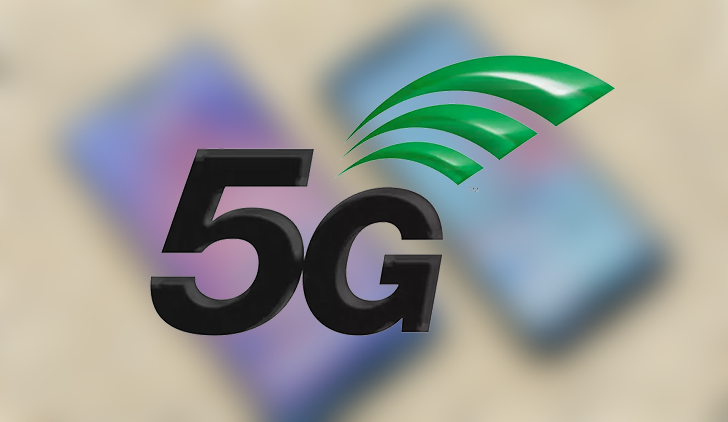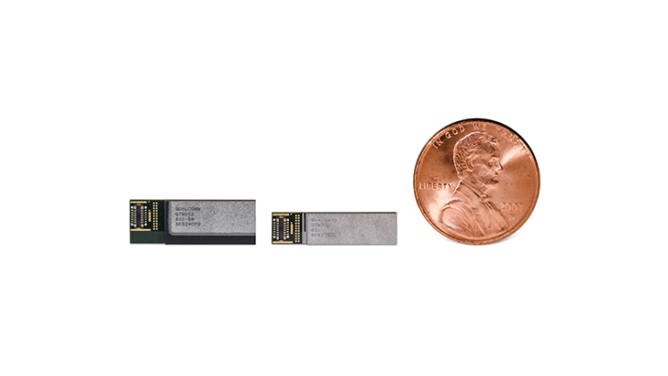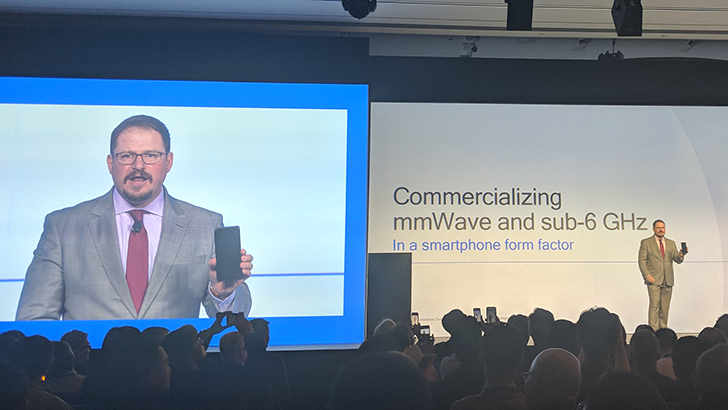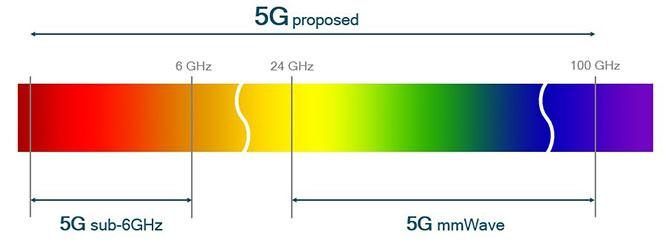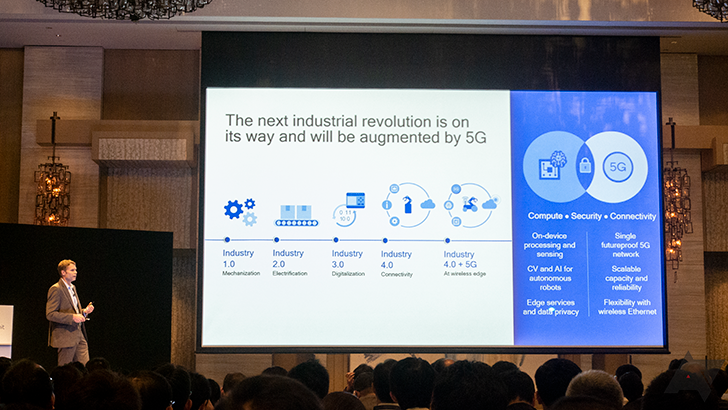5G is coming soon, but if you still have no idea what it is, or why it matters, then you're not alone. It isn't easy to gain a clear understanding of the subject — most explanations on the net end up being half vague marketing jargon and half complex technical details. That's why we're adding a new entry to our layman's guide to 5G in anticipation of the first 5G smartphones and networks in 2019.
Of course, Keegan Michael Key's recent verbal explainer on the subject covers a fair amount on the topic — "It's one better than 4G, and it's two better than 3G" — but in case you want a bit more detail, we'll attempt to set out what you can expect from this new era of wireless, in the clearest terms possible.
Full disclosure: I attended Qualcomm's 4G/5G Summit as part of my information gathering process for this explainer. Qualcomm paid for travel to the 4G/5G Summit, as well as accommodations.
How the first 5G smartphones work
At this year's 4G/5G Summit thrown by Qualcomm I got the chance to briefly hold the chipset giant's latest 5G reference design, which, after years of work, is now the size of an average modern flagship (though perhaps a bit thicker). While the phone was turned off and I couldn't snap pictures, the company did give me a rundown of the 5G components — which should be helpful in understanding the 5G devices due to arrive next year.
The latest, smallest mmWave antenna is in the middle. A larger version is shown on the left.
To begin with, the reference device contains three millimeter wave (mmWave) antennas — one at the top, two on the sides. The distribution is crucial because of the nature of mmWave spectrum. mmWave refers to a high-frequency wireless spectrum that's tricky to work with. So tricky, in fact, that it's only been used for fixed wireless backhaul (transporting data from users to the network backbone) up until this point. This use case, though, didn't pose challenges like navigating indoor spaces.
Managing to tap into mmWave is a significant coup, since spectrum is an increasingly scarce resource. Plus, mmWave makes for faster speeds. At higher frequencies — 24GHz and up — there's room to make wider channels for data, which allows for those multi-gigabit throughputs you might have heard about.
Why is mmWave so tricky? Well, the spectrum's name comes from the actual length of the waves. They're short, ranging from around 10 millimeters to 1 millimeter. Not only are they short, but they're also quite easily absorbed by gases in the atmosphere, reducing range, and can be blocked easily by lousy weather, buildings, trees, and, of course, hands.
Qualcomm president Cristiano Amon shows off the latest 5G reference device.
To solve this, 5G antennas intelligently shoot a narrow beam of mmWave directly at the 5G device antenna. This is known as beamforming. If your thumb happens to be in the way of the beam, the wireless signal is blocked, thus the need to distribute the antenna modules carefully. This isn't a brand new method, 4G devices had distributed antennas too — but mainly just in the top and bottom.
That's where the sub-6GHz 5G antennas sit in this reference device. Sub-6GHz is the other spectrum segment that's playing a large role in 5G coverage out of the gate. It has a longer range and will be crucial to providing pervasive coverage.
Image courtesy of Qualcomm.
Alongside the antenna modules, 5G phones need a Qualcomm X50 modem and a 4G LTE modem. The latter so that your device can fall back to that network seamlessly when 5G isn't available. It'll be that way for a while until 5G becomes ubiquitous. Qualcomm confirmed it is planning to offer an integrated solution around 2021.
So, to recap: mmWave antenna modules (three or four, optimally), sub-6GHz antenna modules (in this case, four), an X50 modem, and an LTE modem. These are the core components that will grace most of the first 5G devices. And I do mean most. Qualcomm has been a highly influential player in 5G, and it supplies chips and modems to a massive segment of Android manufacturers. It has confirmed that it's working with over 20 manufacturers on 5G products, including Google and OnePlus. In fact, during the summit, Amon pulled OnePlus CEO Carl Pei onto the stage to announce that the company would debut what might be the first 5G smartphone next year.
Smartphone makers in the 5G era
From Qualcomm's list of 5G device partners, it seems likely that we'll see a veritable bumper crop of 5G smartphones in 2019. It's important to note, though, that some partners on the list might be working on other types of devices, like equipment for fixed wireless, which Verizon has already debuted (albeit using its own version of 5G). Either way, here's the full list of public partners so far:
- Samsung
- OnePlus
- Nokia (HMD)
- LG
- OPPO
- HTC
- Asus
- Sony
- ZTE
- Xiaomi
- Vivo
- Sharp
- Fujitsu
- Fujitsu Connected Technologies
- Inseego/Novatel Wireless
- NetComm Wireless
- NETGEAR
- Sierra Wireless
- Telit
- Wingtech
- WNC
One notable exception here — apart from the obvious one, Apple — is Huawei, which does have an established working relationship with Qualcomm. In February, when the chipset company named 18 of its 5G device partners, Amon said one manufacturer with a "very large infrastructure business" would use the X50 modem, but wouldn't be speaking publicly about it yet. It's possible that's a reference to Huawei, but considering the political drama that's taken place over the past year or so, it's understandable that the two companies might be cautious about any potential partnership.
Will phones get more expensive?
Probably, but that was a foregone conclusion anyway.
Potential impact of 5G
Will 5G smartphones breathe new life into a stagnating form factor? As with many things in life, it's probably best not to buy too much into the hype.
5G will absolutely provide significantly faster wireless speeds and lower latencies, there's no doubt about that. But don't go by the "theoretical" multi-gigabit top speeds and millisecond latencies you'll see advertised by many companies and carriers. Unless the stars align and there happens to be no one on the network but you, you're not going to get multi-gigabit speeds. You will get better speeds than LTE, though.
Speaking of LTE — it might be helpful to look at 4G's evolution as a reference. At launch, 4G promised 100Mbps speeds. But it's only now, roughly eight years into maturity, that Americans are starting to see speeds like that, and it's still highly dependent on time and area. Mostly, speeds are much lower. Average LTE speeds in the US sit at roughly 16Mbps according to Open Signal's most recent State of LTE report or in the 20Mbps range according to Speedtest by Ookla. That said, 5G will continue to develop and improve just like LTE has, and the speeds will just keep getting faster. But for now, it's probably best not to set any significant expectations. That goes double for rural (and some suburban) consumers. This G is no different from any other Gs. It's mainly for urbanites — and, at the outset, it will be mostly for urbanites in the right places.
One area of concern surrounding mmWave tends to be indoor reception. How will these signals work when they have walls and ceilings to contend with? Interior small cell deployments will of course help boost service, but the actual technology used to combat this issue is beamforming, mentioned above. Beamforming technology allows base stations and devices to communicate and intelligently search for the best path through a layout, beaming the signal off surfaces in order to get to the end user. In fact, some locations that may not seem like a good place for mmWave at first glance — places with lots of metal, notably, are reportedly great for beam bouncing, providing more consistent signals.
5G could lead to new mobile form factors
To sum up the previous section, you should temper your 5G expectations. You'll probably stream and upload a lot more video, so that's cool, but it won't change the nature of the smartphone itself. In an interview with Android Police, Durga Malladi, Qualcomm's senior vice-president of engineering and GM of 4G/5G, noted to me that smartphones only hit mass popularity with 4G, adding: "In 5G, we don't anticipate the only devices will be smartphones."
What comes next? Well, the chipset giant is already putting bets on a few other form factors. There are the fixed wireless devices I mentioned — customer premises equipment, or CPEs — which Verizon is now offering. Plus, there are always-connected laptops, which Qualcomm is championing alongside Microsoft.
"That's all in the next one year," said Malladi, "As we head into 2020, there's the next generation of devices, the mobile XR glasses, and industrial IoT."
Of those two things, mixed reality headgear is definitely the more immediately interesting to consumers. The idea of walking around and seeing an augmented world is sheer sci-fi. It's also equally fascinating and terrifying — this video, which Amazon's Philip Thompson played during the 4G/5G Summit keynote, illustrates that pretty well.
[EMBED_VIMEO]https://vimeo.com/166807261[/EMBED_VIMEO]
Will it actually come to be? Connected glasses do seem inevitable, even though smart eyewear has failed to stick on more than one occasion. Even if it does become the next big thing, does that mean smartphones have to die? Probably not — historic track record shows that new technologies have a tendency to build upon old ones, rather than fully replace them.
5G is designed for machines
Regardless, it might be the boring old Internet of Things (IoT) that will have the largest impact on our daily lives. Qualcomm and many others in the 5G industry think we're on the brink of a new industrial revolution. They're calling it Industry 4.0. What were industries one through three, you ask? Steam, electricity, and internet. Fairly significant turning points in human innovation, to say the least. This is certainly the largest wellspring of 5G hype.
"There's a lot of hope and expectation that if we have a unified connectivity fabric, which is 5G, and we use it everywhere, then information is being generated in every single entity that we can think of," said Malladi.
And that information is valuable. While there are many potential ways for it to be valuable, Qualcomm focuses on how it can be put to work — for instance, in "dark warehouses," where robots communicate with one another and work independent of direct human oversight. 5G paired with AI will allow for robots to really come into their own, according to industry experts. Qualcomm's Amon said during this keynote that if 2G was about communicating human to human, and 3G and 4G were about communication human-to-machine, then 5G is about machine-to-machine communication.
Back to reality
At this point, you may be wondering just how soon a robot will knock on your door to replace you — but the predictions about this new industrial revolution should also be taken with a grain of salt. 5G exists in the future, and we simply don't know how it will affect the world. All we know from the patterns of past technological innovations is that nothing happens the way we think it will.
Thankfully, we don't have to wait too much longer to begin seeing the changes that do arise from 5G. All of the major American carriers have roll-out plans for 2019, as do carriers around the world. See a quick round-up of the latest plans below.
- AT&T promised a dozen cities would have 5G by the end of 2018. Right now, equipment that can eventually deliver 5G has been installed in Dallas, Waco, Atlanta, Oklahoma City, Charlotte, and Raleigh. The carrier plans to complete its rollout within the next few weeks.
- Verizon already has 5G and 5G devices — sort of. It launched fixed wireless service in Houston, Indianapolis, Los Angeles, and Sacramento that works on its 5G TF network this October. It will upgrade this network to standards-abiding 5G when equipment becomes available. Plus, Verizon already made a consumer 5G product available with the 5G Moto Mod.
- T-Mobile recently announced a total $7 billion investment in equipment from Ericsson and Nokia. It also noted that some of its current Ericsson equipment already supports 5G, and will only require a remote software installation. The carrier is planning to launch in 30 cities.
- Sprint (which will likely be T-Mobile soon enough) says its 5G service will initially be available in Atlanta, Chicago, Dallas, Houston, Kansas City, Los Angeles, New York City, Phoenix, and Washington DC. It hopes to launch the first 5G phone with LG in the first half of 2019.
As noted above, anyone can use "5G" to describe their network. There is a set of globally agreed-upon standards, but it's possible to use your own custom version of the new tech (like Verizon) and still call it 5G.
Another element of the 5G discussion that frequently pops up is whether mmWave, the crucial 5G spectrum, is dangerous. I'm not a scientist, but I'll recount my brief research into the topic. Existing literature from the World Health Organization and the International Commission on Non-Ionizing Radiation Protection (ICNIRP), among others, states that there are no proven adverse health effects for high-frequency exposure, apart from potential increases in heat, or localized burns. Qualcomm reports that it stays well within the limits set by ICNIRP and the Federal Communications Commission (FCC). Check out the links to do your own reading, though.
I still don't understand
Totally understandable — that was an overwhelming amount of info. Here's a succinct summary.
5G is the next generation of wireless, and for consumers, it promises multi-gigabit speeds and low latency. Will it get there? Maybe eventually, but not any time in the near future. You should expect speeds of several hundred megabits-per-second, but even then, there are a lot of variables including network congestion and geographic location. Speaking of that, if you live in a rural area, expect all 5G timelines pushed back much farther. If you really live far from an urban area, you probably know how it goes — the wait might be indefinite. Even in urban areas, the rollouts won't be comprehensive right away.
What will 5G change? In terms of smartphones, they may be a bit thicker than usual, and you might have to be careful where you place your hands in order to get mmWave 5G service. But the industry is hoping other use cases will push wireless growth — things like XR headsets and the growth of a massive net of connectivity between machines which could revolutionize any number of industries.
As for 5G smartphones, they're coming next year, and there will be a lot of them from the sounds of it. They will all include LTE modems as a fallback, but the new 5G equipment (and the fact that the device has to hold double the modems), may make them a little pricier.
Ready or not, here the 5G era comes.

